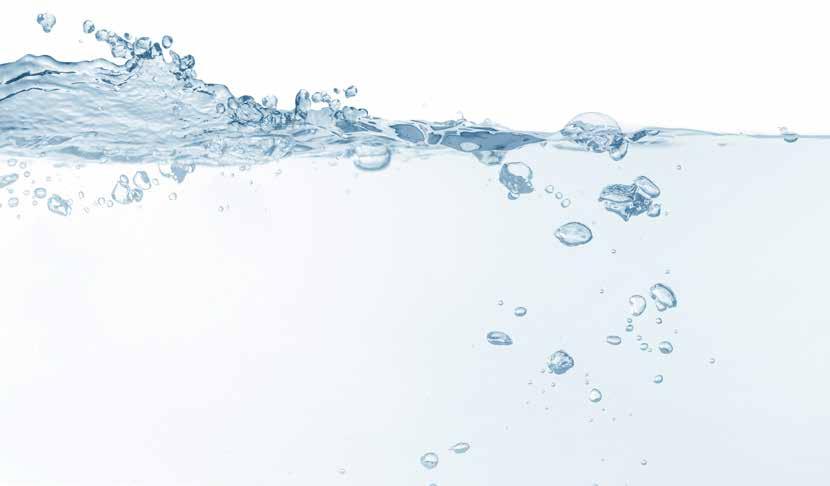
6 minute read
Foreword
South Africa’s water crisis is a living reality

Advertisement
FOREWORD
The water-scarcity situation in South Africa has received increasing attention in recent times, with communities at the receiving end of the crisis. By Mmaphefo Thwala*

Mmaphefo Thwala started her career in the water industry at the Department of Water and Sanitation, where she worked for 10 years
The social impacts have been felt at the household level, as water is a basic need for livelihoods (including drinking, cooking, cleaning and personal hygiene). The past decade has been clouded by recurring water-related service disruptions and protests in various municipal jurisdictions. Water shortages in the Ngqushwa, Maluti a Phofung, Mbombela, Greater Giyani, Sol Plaatje, Sekhukhune, Greater Taung and Polokwane municipalities are among many well-known cases.
The recent Western Cape drought bore evidence to South Africa’s water reality, receiving worldwide attention given the socio-economic importance of the province. Sadly, other provinces (particularly the Eastern Cape, Northern Cape and Limpopo) have faced persistent drought, with residents living in a silent ‘day zero’ situation, including a constant lack of water as the daily norm. Failed water service delivery projects in Limpopo (Giyani Bulk Water Supply Project) and KwaZulu-Natal (Jozini Bulk Water Supply Project) are key examples of the country’s water governance and implementation challenges, attributed to factors such as mismanagement and capacity constraints within water authorities. Authorities are also faced with making provision for rising water demands driven by increasing population and rapid urbanisation.
The onset of the Covid-19 pandemic in 2020 saw these disparities heightened and exacerbated. Access to adequate water, sanitation and hygiene (WASH) has been emphasised by scientists worldwide and the World Health Organization as the first line of defence against the virus. Campaigns to curb the spread of the virus focus on people regularly washing their hands with both water and soap. The pandemic Water user further exposed South Africa’s inequalities in access to water, as many communities education, are still without running water and are awareness and action in subsequently disadvantaged in terms of the form of water use their defence against Covid-19. efficiency are key In the National Water and Sanitation Master Plan, launched in 2019 by the Department of prerequisites for real Water and Sanitation (DWS), the challenges behavioural change.” to the water sector are attributed to factors such as inadequate investment and maintenance of water infrastructure, inefficient pollution control measures and deteriorating water quality. The situation in South Africa is exacerbated by rainfall and subsequent run-off patterns that are highly variable both geographically and seasonally, while the country receives roughly
FOREWORD
half the world’s mean annual rainfall. Moreover, the frequency and intensity of drought and heat events due to climate change have increased.

Water is also a critical primary input resource for all sectors
Water use estimations in South Africa are dominated by agriculture irrigation (61%) and municipal/ domestic water use (27%) respectively. Industry and afforestation account for 3% each, followed by power generation, mining, livestock watering and nature conservation at 2% each. Water is therefore critical for economic growth and sustainability for the country. The mining sector is not exempted from water reliance and has contributed to some of the water challenges

highlighted above, given recent concerns related to acid mine drainage.
The challenges of acid mine drainage contributing to poor water quality have been reported due to mining activities in the Witwatersrand area impacting on the Vaal River Catchment, with those in Mpumalanga impacting on the Olifants River Catchment. Diffuse pollution has reportedly been more pronounced in the cases of the Blesbokspruit and Klip rivers.
South Africa is deemed to have relatively progressive legal frameworks and policies for water resource management; however, the implementation of these legal tools and guidelines has posed various challenges for the country. To this end, various implementation measures and initiatives have been explored. It is clear that a holistic approach to solving water issues for the sector will require participation by all stakeholders, with an integration of efforts and bespoke approaches where required. However, in the short to medium term, the sector needs to adopt a solutions-oriented approach that capitalises on targeting low-hanging fruits for a faster turnaround time on efforts invested. Below are some examples of key actions that could have a largescale impact on water security in South Africa.
Water use efficiency
The above outlined water use per sector in South Africa gives a clear indication that all stakeholders have an important role to play. Water conservation and water demand management (WC/WDM) initiatives ought to be a continuous effort applied by all water users. Municipalities will need to ensure that they develop, implement and monitor their WC/WDM plans. Various approaches, including community awareness campaigns, industrial and agricultural water conservation and water reuse initiatives, as well as municipal leak detection and repair programmes, can all make a significant difference in this regard.
Implementation of initiatives
Fully functional catchment management agencies (CMAs) on a localised level will go a long way in implementing key departmental functions, such as information/ data gathering through monitoring programmes, regulatory functions (such as compliance monitoring) and pollution control.
Infrastructure investments into critical infrastructure initiatives (such as the maintenance of wastewater treatment plants) are critical for reducing the impacts of effluent discharge into surface water resources.
A balance between environmental, social and economic priorities
In order to achieve a much-needed balance between water use for economic development and water protection for domestic and environmental needs, the integration of decision-making processes is key to ensure effectiveness and efficiency in the governance of South Africa’s most basic need.

ESG FOREWORD
The prospect of nature-based solutions offering a sustainable approach has gained traction in the past few years. In South Africa, the DWS and the Department of Environment, Forestry and Fisheries (DEFF) have nationally taken a leadership role with water ecosystem protection programmes such as Water Resource Classification, Reserve and Resource Quality Objectives Determination studies and initiatives such as River Health, Adopt-a-River and the ‘working for’ programmes.
Currently, the National Business Initiative (NBI), alongside the DEFF, South African National Biodiversity Institute, Water Research Commission and Development Bank of Southern Africa are providing targeted support to two catchments in South Africa, focusing on restoring ecological infrastructure for the benefit of water security. This is being done because many of the country’s ecosystems are severely degraded at present, and healthy catchments are essential, not only for ecosystem services, but also for supporting the functioning of engineered water infrastructure.
Water Stewardship
Collaboration among the different spheres of government, the private sector, civil society and communities is critical if we are to overcome South Africa’s current water-related socio-economic challenges. Good examples include the NBI’s Water Stewardship initiatives alongside key partners, which offer a joint approach where all stakeholders play an active role.
These initiatives include the uMhlathuze Water Stewardship Partnership (UWASP), Gauteng Water Alliance, Western Cape Drought Task Force, Annual Water Stewardship Conference and the NBI’s Technical Assistance, Mentorship and Development programme – all of which are undertaken with key partners in the public sector, industry and civil society.

Conclusion
At the heart of the initiatives suggested above is the need for change in societal mindsets, attitudes and beliefs towards water resources. It is for this reason that water user education, awareness and action in the form of water use efficiency are key prerequisites for real behavioral change.
If the mindset and belief systems of a person can be influenced positively, principles of environmental sustainability will be carried forward with them in their decision-making across the organisations, homes and communities they occupy. Hence, a shared responsibility approach is required for turning the situation around. Together, we can each do our part to ensure future water security for all in South Africa.










